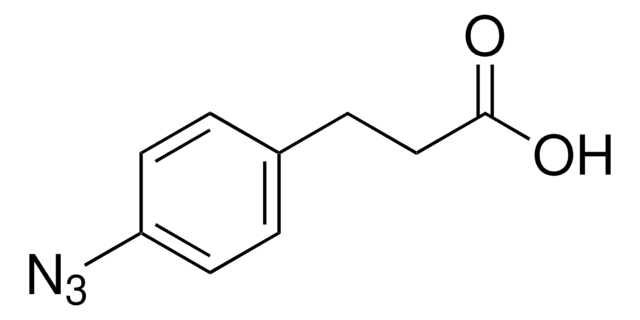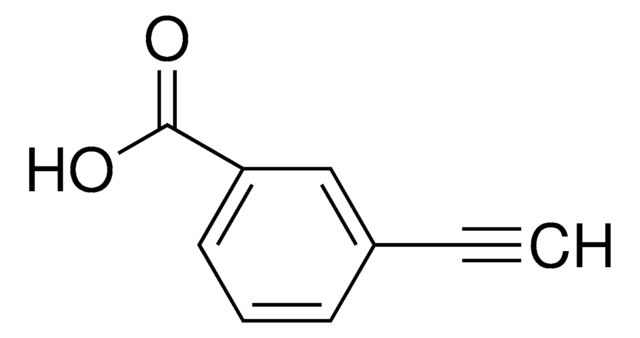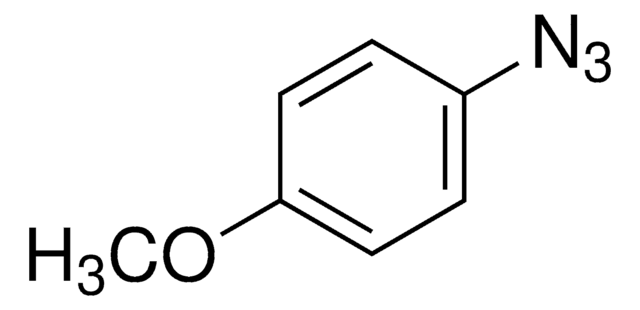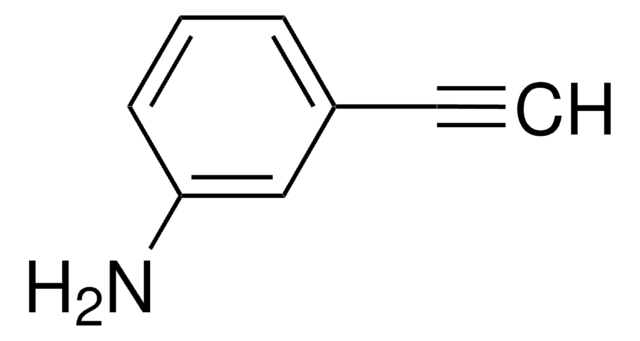778877
4-Azidobenzoic acid solution
~0.2 M in tert-butyl methyl ether, ≥95.0% (HPLC)
Sinónimos:
9-Azidobenzoic acid solution
Iniciar sesiónpara Ver la Fijación de precios por contrato y de la organización
About This Item
Fórmula empírica (notación de Hill):
C7H5N3O2
Número de CAS:
Peso molecular:
163.13
Beilstein:
1950876
Número MDL:
Código UNSPSC:
12352106
ID de la sustancia en PubChem:
NACRES:
NA.22
Productos recomendados
Nivel de calidad
Ensayo
≥95.0% (HPLC)
Formulario
liquid
concentración
~0.2 M in tert-butyl methyl ether
impurezas
≤2.0% water
temp. de almacenamiento
2-8°C
cadena SMILES
OC(C1=CC=C(N=[N+]=[N-])C=C1)=O
InChI
1S/C7H5N3O2/c8-10-9-6-3-1-5(2-4-6)7(11)12/h1-4H,(H,11,12)
Clave InChI
PQXPAFTXDVNANI-UHFFFAOYSA-N
Categorías relacionadas
Descripción general
4-Azidobenzoic acid is an aromatic azide generally used in copper(I)-catalyzed azide-alkyne cycloaddition reactions.
Aplicación
Review
Palabra de señalización
Danger
Frases de peligro
Consejos de prudencia
Clasificaciones de peligro
Flam. Liq. 2 - Skin Irrit. 2 - STOT RE 2
Órganos de actuación
Blood
Código de clase de almacenamiento
3 - Flammable liquids
Clase de riesgo para el agua (WGK)
WGK 3
Elija entre una de las versiones más recientes:
¿Ya tiene este producto?
Encuentre la documentación para los productos que ha comprado recientemente en la Biblioteca de documentos.
I F Luescher et al.
Immunity, 3(1), 51-63 (1995-07-01)
To study the interaction of the TCR with its ligand, the complex of a MHC molecule and an antigenic peptide, we modified a TCR contact residue of a H-2Kd-restricted antigenic peptide with photoreactive 4-azidobenzoic acid. The photoreactive group was a
Kai Ling et al.
Journal of biomedical materials research. Part A, 87(1), 52-61 (2007-12-15)
Hydroxypropyl chitosan (HPCS), a water-soluble chitosan derivate, was modified by introducing photoreactive azide groups (4-azidobenzoic acid, Az-) to the amino groups of HPCS, resulting in a photocrosslinkable Az-HPCS. Novel porous chitosan scaffolds thus were fabricated by ultraviolet (UV) light irradiation
Stefan Müller et al.
Journal of materials chemistry. B, 8(3), 416-425 (2019-12-14)
Here, the surface of silicone elastomer was modified with photo-reactive gelatin bearing azidophenyl groups. Two types of gelatin were prepared: one by coupling with azidoaniline and the other by coupling with azidobenzoic acid. The silicone surface was hydrolyzed by oxygen
P Romero et al.
Journal of immunological methods, 171(1), 73-84 (1994-05-02)
A novel procedure is presented describing the induction of antigen-specific cytolytic T lymphocytes (CTL) in vivo, that uses as immunogen syngeneic Concanavalin A stimulated spleen cells expressing H-2Kd (Kd) molecules photocrosslinked with a photoreactive peptide derivative. The Kd restricted Plasmodium
Aiping Zhu et al.
Biomaterials, 23(23), 4657-4665 (2002-09-27)
Chitosan (CS) was covalently immobilized onto polylactic acid (PLA) film surface using the photosensitive hetero-bifunctional crosslinking reagent, 4-azidobenzoic acid, which was previously bonded to chitosan by reaction between an acid group of the crosslinking reagent and a free amino group
Nuestro equipo de científicos tiene experiencia en todas las áreas de investigación: Ciencias de la vida, Ciencia de los materiales, Síntesis química, Cromatografía, Analítica y muchas otras.
Póngase en contacto con el Servicio técnico











